|
According
to Hindu mythology, Goddess Durga is the mother of
mankind and is believed to be the power behind the
creation, preservation, and destruction of the universe.
The Hindu warrior Goddess Durga is typically portrayed
as a beautiful woman with ten arms that bear divine
weapons to protect each one of us. Her role in Indian
mythology is very strong and powerful. She has been
worshipped as the supreme power of the universe. She is
a multi-dimensional Goddess, with many names and many
personas. |
|
History behind the
Birth of Goddess Durga |
|
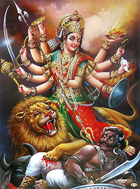 |
There
is an interesting legend behind the birth of Maa Durga.
According to this legend, Durga was created for the
slaughter of the buffalo demon Mahishasura. Mahishasura
is a demon who earned the favour of Lord Shiva after
long and hard penance. Authorized with the boon,
Mahishasura started his reign of terror over the
universe and people by slaying them mercilessly. The
other Gods and sages were extremely harassed by the
terror of Mahishasura and pleaded Lord Shiva to protect
their world from this buffalo demon. Lord Shiva advised
all the Gods to release their divine powers as it was
seemed that the joint energy of powers was the only
thing capable of conquering Mahishasura. The divine
powers of all the Gods emerged into female form. These
powers fused together in shining light from which arose
a magnificent Goddess with many arms. She was born
fully-grown and is depicted as remarkably beautiful and
full of rage. The Gods named this Goddess as DURGA. Gods
armed her with all their weapons. Thus heavily armed Maa
Durga rode to the top of a mountain on a lion. |
|
In a fierce battle, she defeated Mahishasura and his army of demons and thus saved the
Universe from this demon’s threat. Therefore, MAA DURGA
is also called Mahishasuramardini (the demolisher of
Mahishasur). This holy battle indicates the triumph of
Good over Evil. DURGA PUJA is observed in honour of
Godess Durga , to celebrate her victory over evil and
conquering the unconquerable. |
|
The Legend of Maa
Shakti - Famous Shakti Peeths of Maa Shakti |
|
In the
Satyuga Maa Sati was the daughter of King Daksh
Prajapati (son of Lord Brahma). She married to Lord
Shiva against the wishes of her father. , Daksha
Prajapati performed a yagna with a desire to take
revenge on Lord Shiva. Daksha was angry because his
daughter Sati had married Lord Shiva against his wish.
Daksha invited all the deities to the yagna, but he did
not invite Lord Shiva and Sati. The fact that she was
not invited did not discouraged Shakti (Sati) from
attending the yagna. She had expressed her desire to
attend the Yagna to Shiva who had tried his best to
dissuade her from going. Shiva eventually allowed her to
go escorted by his followers. But Sati, being an
uninvited guest, was not given any respect by her
father. Furthermore, Daksha insulted Shiva even in his
absence in front of all the guests who have come to
witness the Yagna. Shakti was unable to bear her
father’s insults toward her husband, so Devi Sati
invoked her yogic powers and immolated herself. When
Lord Shiva came to know of the incident, he got
extremely angry and started his dance of destruction
with the body of devi Sati being held in his arms. The
world was terrorized from this Tandava Nritya and to
stop the devastating penance, Lord Vishnu used his
Sudarshan chakra and cut the Sati’s complete body in
several pieces. Wherever her body parts fell on earth, a
temple was erected known as Shakti Peeth to commemorate
Devi Shakti and became a Hindu pilgrimage. These Shakti
Peeths are scattered all over India. |
|
Nine Divine Nights of Navratri |
|
Navratri is celebrated all over India and is said to be
the festival which shows the various colors of India. "NavRatri"
literally means "Nine Nights." This Year
Navratri will be celebrated from 10th of October
till 18th of October 2018. The festival of Navratri
is celebrated with prayers in the beginning of the
Ashwin (autumn) month and the beginning of Chaitra
(spring) month. Navratri, the festival of nine nights is
dedicated to the nine forms of
Goddess Durga who occupies a special place in the
Hindu Religion. During the nine days of Navratri, a
large number of Devotees observe fast for the entire
period. During evenings people perform religious dances
in order to worship Goddess Durga Maa. |
|
Goddess Navdurga in Nine forms |
|
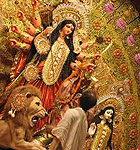 |
Nine
forms of Shakti are worshipped during the Navratris.
Every day, she assumes a new incarnation, having a new
look and name. Each Goddess has a different form and
special significance.
The message that Goddess Durga gives to her devotees is
that with the force of dignity and wisdom, we can
achieve the victory over all the demonic forces inside
us. |
|
Nine
Days & Nine Forms of Maa Durga |
|
 |
First
Day of Navratri :
On the first day of Navratri, Goddess Durga is
worshipped as 'Shailputri' She is considered the
daughter of the Himalayas. This form of Goddess Durga
rides a bull and carries a trident and a lotus in her
two hands. |
|
 |
Second
day of Navratri :
The second form of Goddess Durga is known as 'Brahmacharini'.
She is also a form of Uma or Parvati. She is blissful
and bestows happiness, peace, prosperity and grace upon
all devotees who worship her. Worshiping this form of
Goddess Durga is also a way to attain Moksha. |
|
 |
Third
day of Navratri :
On the third day of Navratri the Goddess is worshipped
as 'Chandraghanta'. She is the symbolic
representation of beauty and bravery. She has a
‘chandra’ or half moon on her forehead in the shape of a
‘ghanta’ or bell. That is why she is called ‘Chandraghanta’.
She is charming and has ten hands, three eyes and holds
weapons in her hands. |
|
 |
Fourth day of
Navratri :
On the fourth day of
Navratri the Goddess is worshipped as 'Kushmanda'. It is believed that
Kushmanda is the creator of the entire Universe which she has created by her laugh. The universe was full of darkness, until
her light spreads in all directions like rays from the sun. She has
eight or ten hands and holds weapons, glitter, rosary, etc., in her
hands. |
|
 |
Fifth
day of Navratri :
On the fifth day of Navratri, Goddess is worshipped as
'Skand Mata'. She is actually called so because
she is the Mother of Skanda, the chief warrior of the
Gods army. She is accompanied by the Lord Skanda in his
infant form. Skanda Mata has four arms and three eyes,
holds the infant Skanda in her right upper arm and a
lotus in her right hand which is slightly raised
upwards. The left arm is in pose to grant boons with
grace and she holds a lotus in left lower hand which is
also raised. |
|
 |
Sixth
day of Navratri :
On the sixth day, the Goddess is worshipped as 'Katyayani'.
Goddess Katyayani rides on a magnificent Lion and she
has four hands. She carries lotus flower and sword in
her right hands and keeps her left hands in Abhaya and
Varada Mudras. |
|
 |
Seventh
day of Navratri :
On the seventh day, the Goddess is worshipped as 'Kalratri'.
Her complexion is dark black and she rides on a donkey.
She is depicted with four hands. Her right hands are in
Abhaya and Varada Mudra and she carries sword and the
deadly iron hook in her left hands. |
|
 |
Eighth day of Navratri :
On the eight day, the Goddess is worshipped as 'Maha
Gauri'. She is considered to be extremely beautiful,
white like snow and she wears white colored ornaments.
She represents calmness and exhibits Wisdom. Her power
is unfailing and praying to her is instantly
fruitful. The left upper hand holds a ‘Damaru’ and the
lower one is in the pose of granting boons to her
devotees. |
|
 |
Ninth day of Navratri :
On the ninth day, the Goddess is
worshipped as 'Siddhidatri'. It is believed she is bestower of all the eight
Siddhis. She lives on lotus and has Supernatural healing
powers. In ‘Devi Bhagvata Purana’ it is mentioned that Lord Shiva
worshipped her and was blessed with all Siddhis (supernatural powers).
By her blessings his half body became female and other half body male in
the avatar of Ardhnarishwar. |
|
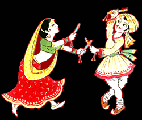 |
Garba is
a form of dance that has originated in the state of
Gujarat in India. Traditionally, this dance is performed
around a clay lantern with a light inside, called a Garbha
Deep and the name Garba has been given due to this
reason. However, Nowadays the Garba dances are performed
with a lot of enthusiasm and vanity. Huge Pandals are
erected along with a big stage where professional
musicians and singers perform Garba tunes. Thousands of
people of every age dance on these tunes for the entire
night. Many people are dressed in special attire known
as Garba dress. At some venues even the prizes are given
to good performers at the end of every night. |
|
Famous
Temples of Goddess Durga in India |
|
Goddess
Durga is worshipped in every part of India in various
forms. The temples of Goddess Durga are also spread all
across India. Indian temples have always played a vital
role in promoting and flourishing the Hindu culture and
philosophy. The temples of Goddess Durga provides an
opportunity for the Hindu community to worship and
display the many characteristics possessed by Goddess
Durga by participating in various rituals, festivals and
other activities of the temple. |
|
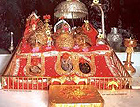 |
Vaishno Devi Temple :
Vaishno Devi Temple is one of the holy Hindu temples
dedicated to Maa Shakti ( Goddess Durga ) and is located
in Trikuta Mountains within the Indian states of Jammu
and Kashmir. Vaishno Devi Temple is the second most
visited temple in India after Tirumala Venkateswara
Temple. Here, Maa Vaishno Devi resides in the holy caves
located in the folds of the three mountain peeks called
Trikuta. It is a great belief among the devotees that
Goddess Vaishno sends a ‘Call’ to her Devotees and once
a person receives it, wherever he or she is, marches
towards the holy shrine of the great Goddess. |
|
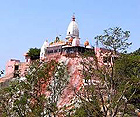 |
Mansa
Devi Temple :
Mansa Devi temple is located in the holy city named Haridwar in the
Uttarakhand state of India. It is located in Shivalik Hills. The
temple is considered a must visit destination for the pilgrims going to
Haridwar. The temple is known for being the home of Goddess Mansa, who
was the wife of Nag Vasuki and also the brainchild of Saint Kashyap. |
|
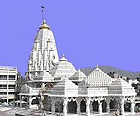 |
Ambaji Temple :
Ambaji Temple is situated in Banaskantha district of
Gujarat. It is one of the 51 Shakti Peethas of Goddess
Shakti. It is believed that the Heart of Goddess Sati
has fallen here. Maa Ambaji rests on Gabbar hilltop in
the town named Ambaji. On every full moon day, a large
number of devotees visit the temple. A grand fair is
held on the full Moon day of Hindu Calender Month of
Bhadarva. |
|
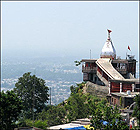 |
Chandi Devi Temple :
Chandi Devi Temple is the holy Hindu temple dedicated to
Goddess Chandi Devi, located in the city of Haridwar, in
Uttarakhand state of India. Suchat Singh, the ruling
king of Kashmir built the Chandi Devi temple in 1929.
However, it was believed that the idol present in the
temple was installed in 8th century, by Jagadguru Shree
Adi Shankaracharya. The main temple is situated on top
of Hill peak. It is one of three Siddh Peethas located
in Haridwar, the other two being Mansa Devi
Temple and Maya Devi Temple. |
|